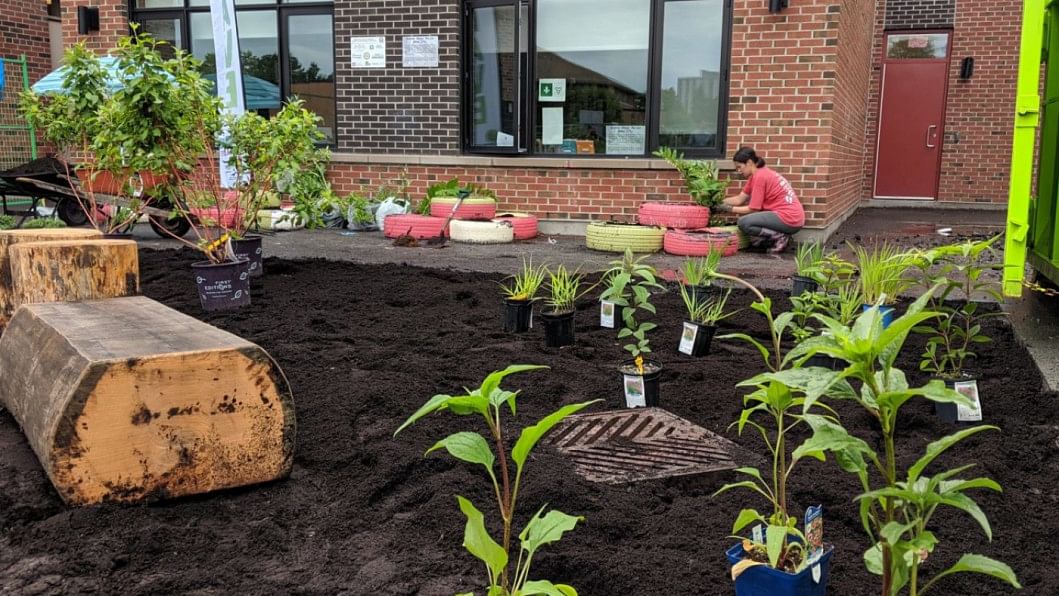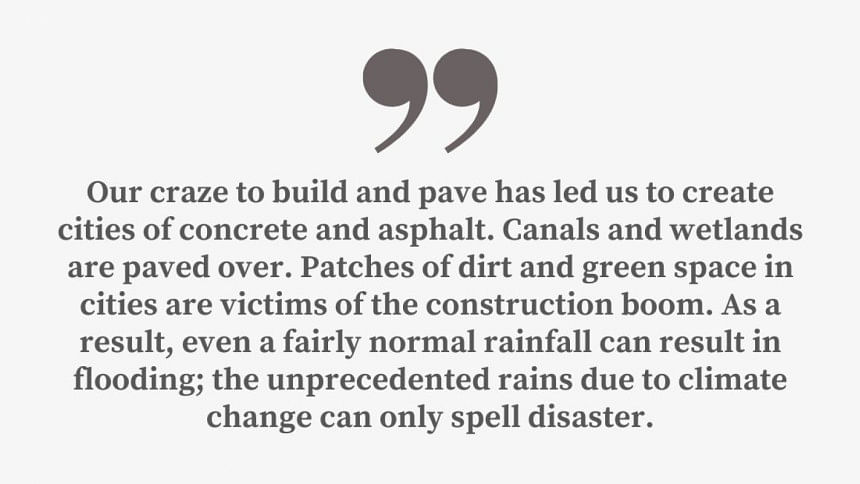Less flooding, more liveability

"Nothing is inevitable but death and flooding" might be our new motto as vast tracts of Bangladesh regularly go under water. So do Miami and other cities around the world. There are a couple of simple reasons why flooding is now inevitable. One is the climate crisis, which guarantees ever more epic climate events, including forest fires, droughts, storms, and flooding. Another is our inability, as modern humans, to accept the simple fact that water requires an outlet.
With burgeoning populations and increasing wealth, there are ever greater demands for construction. Our craze to build and pave has led us to create cities of concrete and asphalt. Canals and wetlands are paved over. Patches of dirt and green space in cities are victims of the construction boom. As a result, even a fairly normal rainfall can result in flooding; the unprecedented rains due to climate change can only spell disaster. We can build high-rise buildings, elevated expressways, and grand monuments, but we can't build our way out of the climate crisis.
We must act dramatically and rapidly to reduce our greenhouse gas (GHG) emissions. But the climate crisis is already here; we can only prevent its worst consequences. In the meantime, we also need to accept that fires, droughts, and flooding are part of the "new abnormal."

But that doesn't mean that we are helpless in the face of the disasters that we human beings have wrought due to our mindless construction and consumerism. At least in terms of flooding, there are some relatively simple activities that would reduce the problem. If we eliminate drains and water bodies while entirely paving over our cities, our cities will get flooded. In the past, the primary aim of municipal storm water management was drainage. More recently, localities have shifted to a focus on minimising run-off by returning rain to natural pathways, such as soil, vegetation, and the atmosphere. If we allow water to seep into canals, rivers, and soil, then flooding will be lessened, as will the pollution of our water bodies by all the chemicals that floodwaters carry with them.
And hence, the idea of green infrastructure and depaving. Green infrastructure can include rain gardens, permeable pavement, green roofs, urban trees, and rainwater harvest and reuse. Green infrastructure means preserving and maintaining canals and rivers in their natural state, rather than encroaching on them or paving them over. Depaving is one of the steps to achieve green infrastructure in an overly built-up city. It is a multi-step process: Stop covering your city in asphalt and cement, start implementing green infrastructure in new projects, and depave where possible. Restore canals and other water bodies. Policies and financial incentives are a necessary adjunct to achieve the needed results.
It may all seem like a lot of work, but consider the benefits. We already know about the losses incurred by flooding: Economic losses of property and ability to work, and personal losses of property, land and lives. By beginning to reverse the damage, other significant benefits would also accrue. First, of course, is flood risk reduction and climate change adaptation. With more natural filtration of water, there would be less sewer overflow, thus some measure of water quality protection. Green infrastructure combined with grey (cement and asphalt) is cheaper than grey infrastructure on its own; it is also more labour-intensive in its maintenance, creating new green jobs. Green infrastructure is vastly more aesthetic, increasing opportunities for tourism, recreation, and urban liveability. More trees are good for mental health; more shade and urban heat island mitigation would also make it easier for people to use active transport (walking and cycling), which improves health and reduces deadly pollution and road crashes.
Joni Mitchell's song Big Yellow Taxi includes the line, "Don't it always seem to go/That you don't know what you got 'til it's gone/They paved paradise and put up a parking lot." It's time to depave the parking lot and return some paradise to our cities. And, as a not-unimportant result, also decrease urban flooding. Despite appearances, not all our urban problems are inevitable.
For more information, visit www.raincommunitysolutions.ca and https://depaveparadise.ca/
Debra Efroymson is executive director of the Institute of Wellbeing and author of Beyond Apologies: Defining and Achieving an Economics of Wellbeing.

 For all latest news, follow The Daily Star's Google News channel.
For all latest news, follow The Daily Star's Google News channel. 








Comments